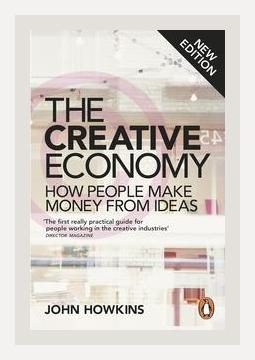Innovation and CreativityR&D Management
**
Introduction
John Howkins’ book, “The Creative Economy: How People Make Money From Ideas,” investigates the dynamics of how creativity has become a central driving force in the global economy. He presents creativity not just as an artistic trait but as a powerful economic asset. Through detailed analysis and numerous case studies, Howkins uncovers how various industries and individuals monetize their ideas.
Chapter 1: Defining the Creative Economy
In this chapter, Howkins differentiates between the traditional industrial economy and the emergent creative economy. The creative economy thrives on the production of ideas, emphasizing activities where creativity is key.
Key Points and Actions:
- Understanding Creative Products: Creative products include anything from art to software and patents.
- Action: Identify what qualifies as a creative product in your field and explore its market potential.
- Measuring Value: Howkins introduces metrics to evaluate intellectual property and creative content.
- Action: Conduct an audit of your creative assets and their value to better understand their market value.
Chapter 2: The Role of Intellectual Property
Howkins highlights the importance of intellectual property (IP) as a foundation of the creative economy. IP rights enable creators to profit from their ideas and protect them from unauthorized use.
Key Points and Actions:
- Types of Intellectual Property: Includes copyrights, patents, trademarks, and trade secrets.
- Action: Secure appropriate IP protection for your creations to safeguard and maximize their value.
- Case Example: Disney’s use of IP to extend the value of its characters and stories.
- Action: Leverage IP to create multiple revenue streams from a single creative work, similar to how Disney expands its franchises.
Chapter 3: The Creative Process
Howkins breaks down the creative process into stages: imagining, developing, designing, and implementing.
Key Points and Actions:
- Stages of Creativity: From brainstorming (imagining) to actual product release (implementing).
- Action: Develop a structured creative process that takes your idea from conception to market launch.
- Creative Environments: The role of environments that foster creativity, like Silicon Valley.
- Action: Cultivate or seek out environments that support and nourish your creative efforts.
Chapter 4: The Business of Creativity
This chapter explores how creative businesses operate differently from traditional ones, focusing on innovation, flexibility, and collaboration.
Key Points and Actions:
- Innovation and Adaptability: Creative businesses need to be agile and innovative.
- Action: Adopt flexible business models that can quickly adapt to market changes.
- Collaboration: Emphasizes partnerships and networking.
- Action: Actively seek out collaborations and partnerships to enhance creative output and market reach.
Chapter 5: Financing Creativity
Howkins discusses the various forms of financing available to creative businesses, such as venture capital, crowdfunding, and government grants.
Key Points and Actions:
- Access to Funds: Understanding different financing options.
- Action: Develop a funding strategy that aligns with your project’s needs, exploring various sources of capital.
- Case Example: Film production financing often involves multiple stakeholders and funding sources.
- Action: Create detailed and compelling proposals for potential investors or grant bodies.
Chapter 6: Creativity in Various Sectors
The book looks into how creativity plays a role in different sectors like media, technology, fashion, and more.
Key Points and Actions:
- Sector-Specific Strategies: Each sector has unique challenges and opportunities.
- Action: Tailor your creative approach and business strategy to fit the nuances of your specific industry.
- Case Example: The gaming industry, where storytelling and design meet technology.
- Action: Integrate multidisciplinary skills to enhance the marketability of your products.
Chapter 7: Global Impact of the Creative Economy
Howkins explores the global nature of the creative economy, emphasizing international collaboration and the global marketplace.
Key Points and Actions:
- Global Collaboration: Creators often work across borders, leveraging global talent.
- Action: Expand your network globally and seek cross-border collaborations to enhance creativity and market reach.
- Case Example: Bollywood’s increasing collaboration with Hollywood.
- Action: Look for international opportunities to diversify and expand your market presence.
Chapter 8: The Future of the Creative Economy
This chapter delves into emerging trends and the future landscape of the creative economy, including digital technology and new distribution models.
Key Points and Actions:
- Technological Advancements: Digital platforms revolutionize how creative content is distributed and monetized.
- Action: Embrace new technologies and platforms to distribute your creative work widely and innovatively.
- Case Example: The rise of digital platforms like YouTube for content creators.
- Action: Utilize digital platforms to reach new audiences and monetize creative content.
Conclusion
John Howkins’ “The Creative Economy” sheds light on the transformative power of ideas and creativity in modern economies. It underscores the significance of intellectual property, structured creative processes, agile business models, and global perspectives. To thrive in this new economy, individuals and businesses must embrace innovation, protect their intellectual assets, and cultivate environments that foster creativity.
Actions for Readers:
- Audit and Protect IP: Regularly check and secure intellectual property.
- Innovate Constantly: Stay adaptable and continuously seek innovative solutions.
- Network Globally: Build international partnerships for wider market reach.
- Leverage Digital Platforms: Use emerging technologies and digital platforms effectively.
- Invest in Creative Environments: Create or find spaces that promote creativity and collaboration.
By following these insights and actions, readers can effectively navigate and succeed in the creative economy.
